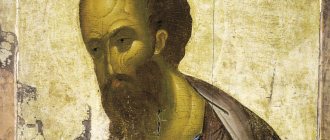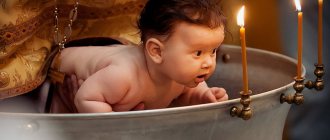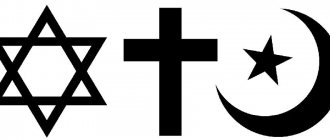Author: Mithun Chakrabortenkov
27 June 2021 16:03
Tags: spirituality interesting religion do it yourself
2342
8
When we tell other people that we consider ourselves spiritual people, they often mistakenly think that we are talking about religion - in one form or another. Sometimes they go so far as to consider spiritual people to be some kind of cultists - mainly because they know little about what we mean by this word, and they are afraid that we are trying to manipulate them.
0
See all photos in the gallery
But if you take a good look at spirituality and try to understand what it is, any sane person will easily understand that this is not a religion at all, that there is nothing mysterious in it, much less supernatural, and that the word “sect” » is least applicable to her. These 7 differences between religion and spirituality will help you understand what spirituality is all about.
Religion makes you bow down to it - spirituality gives you freedom
Religion forces you to follow a certain ideology, and fulfill a certain set of rules, otherwise promising us heavenly punishment. Spirituality helps us follow our hearts and do what we think is right. It helps us achieve in life what we really think is right - without looking at the holy books, with which we do not always agree from beginning to end. It allows us to choose what to believe in enough to give it divinity.
0
Religion Plays on Our Fear - Spirituality Helps Us Find Courage
Religion tells us what we should be afraid of and what we face for it. Spirituality makes us aware of the consequences, but does not make us focus on the negative. She helps us move forward no matter what. Helps us do what we think is right - despite any possible consequences. She shows us how to base our actions on love, not hate, and helps us overcome fear and turn it to our advantage.
0
Religion claims to have revealed the truth; spirituality encourages the search for truth.
There are no religions that are not filled with rigid, once and for all established dogmas that tell you how and what you must believe. Spirituality allows you to go in search of your own truth, a path known only to you, and to understand it in a way that only you can. It allows us to look inside ourselves, and, plunging into the depths of our own soul, understand once and for all that truth is called truth because it is the same for each of us. But it also allows us to believe in our truth - in the truth that we see through the prism of our heart.
0
Religion tries to distance us from other religions; spirituality tries to bring them closer together.
There are many religions in our world, the ministers of each of which, as a rule, teach their followers that only it is true, and only it is worthy of following. Spiritual people see the truth in all these religions, and try to find commonality in them, since the truth is always the same for everyone, despite all our uniqueness and all our differences. Spiritual people try to penetrate into the essence of the message that all religions contain, and pay little attention to the form in which they contain it.
0
Definition of the concept
Religion is one of the most ancient social institutions. It appeared much earlier than the state, the institution of the family. The first religious beliefs arose out of people's need to explain various natural phenomena. Then science began to actively develop and the explanatory function of the incomprehensible passed to it. At the same time, religion retained only its social functionality.
As a result, we can define the concept of religion - this is a special type of human worldview based on belief in the supernatural, as well as various organizations thanks to which religious symbols and ideas exist, for example, the church.
Religion makes you dependent on it - spirituality leads to independence
Adherents of most religions believe that you are truly worthy of happiness and good luck only if you are an active supporter of it and regularly participate in all the necessary rituals. Spirituality shows us all that we don't have to rely on or depend on anything to be happy. The roots of happiness always grow from ourselves, and it depends only on us whether it will grow green or fade. Remember - we are always in exactly the place and time that allows us to be happy. We do not need to attend certain events or events for this. Divinity is in each of us. And we deserve it. Always.
0
Shintoism
Photo: Icon-icons
The main concept is the need to accept your place in the world. Yes, there are tons of gods, spirits, demons and ancestral souls. Yes, there are endless rebirths. But you don't have to do anything about it. Just live in harmony with all this - and you will be happy. There is no hell, no salvation, no torment. There is some karma, but it doesn’t matter. The world, in the understanding of Shintoists, is initially a good thing, and all the problems in it are only because someone desperately does not want to seek harmony.
Religion is based on the fear of punishment - spirituality reminds us of karma
Religion tells us that if we do not obey a certain set of rules, after death somewhere out there, in another world, we will be punished for this. Spirituality helps us understand that every action we commit has its own consequences, and that they can ultimately become our blessing or punishment - for which we do not need to wait for divine judgment. The consequences of our actions depend only on the fundamental laws of this universe - regardless of whether you believe in them or not.
0
Comparative characteristics of world religions
Basic provisions of the Christian Church -dogmas – defined in the 12 articles of the Creed.
Among them, the most important dogmas are: the dogma about the essence of God, about the trinity of God, about the incarnation, atonement, ascension, resurrection, etc. So, as a result of the first seven Ecumenical Councils, the Orthodox doctrine was formed. This creed is reproduced daily by Christian believers in the form of a prayer - “I Believe”, as a sign of recognition of the main provisions of the creed. Briefly, the content of the Orthodox doctrine can be presented as follows:
Orthodox believe in one God, who created the whole world, including man. This God, according to Orthodox concepts, represents the identity of three equal persons: God the Father, God the Son and God the Holy Spirit; into the original sin, which was committed by the first people Adam and Eve; at the second coming of Jesus Christ - God the Son, who became man (that is, took on human form, being born through the virgin birth from the Virgin Mary) and voluntarily offered himself as a sacrifice for the sins of mankind (was crucified on the cross and was resurrected on the third day, and After 40 days he ascended into heaven) and will come again a second time in power and glory to judge the living and the dead and establish his eternal kingdom on earth as in heaven, in which the righteous will bliss and sinners will be tormented forever. Orthodox believe in the immortality of the soul, in the existence of hell and heaven, where the souls of the dead reside until the Last Judgment. According to the Orthodox faith, salvation can only be achieved within the framework of the church, which is the “mystical body of Jesus Christ,” a mediator between God and man.
In Orthodoxy, like any other religion, a system of cult actions is closely connected with dogmatic dogma. The basis of these religious actions are seven main rites - sacraments. The sacrament of baptism is one of the main sacraments symbolizing the acceptance of a person into the bosom of the Christian church. performing the sacrament of communion or the Holy Eucharist (thanksgiving sacrifice). The performance of the sacrament of repentance (confession) is an indispensable attribute of the religious life of an Orthodox Christian. The sacrament of confirmation is also an important part of many cultic activities. In the Orthodox Church, confirmation occurs immediately after the rite of baptism. The sacrament of marriage - church coverage of the ceremony of marriage or wedding - is also an important moment in a person’s religious life. The sacrament of consecration of oil (unction) is performed on a sick person. The ritual consists of smearing the forehead, cheeks, lips, hands and chest with consecrated wooden oil - oil, accompanied by the reading of prayers in which the clergy ask God to grant the sick recovery. The sacrament of the priesthood is performed on the basis of a special rite of ordination - ordination, during which the hands of a superior clergyman are laid on the head of the initiate. It is believed that at the moment the bishop lays hands on the head of the person being ordained as a presbyter or deacon, divine grace is transferred to the latter, making him a mediator between God and people. In addition to performing the sacraments, the Orthodox cult system includes prayers, worship of the cross, icons, relics, relics and saints .. Worship of the cross is one of the most important elements of the Orthodox cult. The cross is a symbol of the Christian faith. The cult of icons - painted or relief images of God the Father, God the Son, God the Holy Spirit, the Trinity, the Mother of God, saints, evangelists, etc. is widespread in Orthodoxy. Orthodox believers also venerate holy relics. The cult of saints is closely related to the cult of relics. Holidays and fasts occupy an important place in the Orthodox cult.
Orthodoxy accepts the decisions of only the first seven Ecumenical Councils. Catholicism continued to develop its dogmatics at subsequent councils. Therefore, the basis of the doctrine of Catholicism is not only the Holy Scripture, but also the Holy Tradition, which is formed by the decisions of the 21st Council, as well as official documents of the head of the Catholic Church - the Pope. Orthodox teaching believes that in the afterlife, the souls of people, depending on how a person lived their earthly life, go to heaven or hell. The Catholic Church formulated the dogma of purgatory - a place intermediate between hell and heaven. According to Catholic doctrine, the souls of sinners who have not received forgiveness in earthly life, but are not burdened with mortal sins, reside in purgatory. They burn there in a cleansing fire. From the point of view of Catholicism, the fate of the soul in purgatory can be eased and its period of stay there shortened by “good deeds.” Closely related to this dogma is the doctrine of the stock of good deeds. Based on this teaching, in the Middle Ages, right up to the 19th century, the practice of selling indulgences became widespread in Catholicism. An indulgence (translated from Latin: mercy) is a papal letter testifying to the remission of sins. Catholicism is characterized by sublime veneration of the Mother of God - the Mother of Jesus Christ - the Virgin Mary. In 1854, Pope Pius I proclaimed the dogma of the Immaculate Conception of the Virgin Mary. In continuation of this tradition, in 1950, Pope Pius XII approved the dogma of the bodily ascension of the Mother of God. One of the specific features of Catholicism is the doctrine of the primacy of the Pope over all Christians. This teaching is associated with the claim of Catholicism to be the only, true and complete embodiment of Christianity, at the First Vatican Council (1870) the dogma of the infallibility of the Pope was adopted. According to this dogma, the Pope is infallible when speaking officially (ex kathedra) on matters of faith and morals. In other words, in all official documents and public speeches, God himself speaks through the lips of the Pope.
An important difference between Catholicism and Orthodoxy is the social status of priests. In Catholicism, starting from the 11th century, celibacy has been in force - mandatory celibacy of the clergy, in contrast to Orthodoxy. In Orthodoxy, the clergy is divided into two categories: black and white. The black clergy are monks. White - clergy who did not take a vow of celibacy. The highest officials in Orthodoxy, starting with bishops, can only be monks. Parish priests tend to be white clergy. The originality of Catholicism is manifested not only in its doctrine, but also in its religious activities, including the performance of the seven sacraments. For example, the sacrament of baptism is performed by pouring water or immersion in water. The sacrament of confirmation in Catholicism is called confirmation. If among the Orthodox this sacrament is performed soon after birth, then in Catholicism confirmation is performed on children and adolescents aged 7-12 years. The sacrament of communion (the Eucharist for the Orthodox) is performed using leavened dough. Orthodox prosphora is a small bun. In Catholicism, prosphora is baked from unleavened dough in the form of a small pancake.
The process of worship also differs. In an Orthodox church, worship is performed standing or believers can kneel. In a Catholic church, believers sit during services and stand only when certain prayers are chanted. In an Orthodox church, during the service, only the human voice sounds in the form of musical accompaniment: the priest, deacon, choir and believers sing. In a Catholic church there is instrumental accompaniment: an organ or harmonium sounds. From this we can conclude that the Catholic Mass is more magnificent, festive in nature, in which all types of art are used to influence the consciousness and feelings of believers.
There are no canonical rules strictly distinguishing between the appearance and decoration of churches in Orthodoxy and Catholicism. However, in the Orthodox church, paintings - icons - predominate. The holy place - the altar - is fenced off from the main hall by a special structure - the iconostasis. In a Catholic church, the altar is open to all eyes and the sacrament of communion of priests performed there is seen by all people. The predominant religious element in a Catholic church are sculptural images of Jesus Christ, the Virgin Mary, and saints. However, in all Catholic churches, fourteen icons are hung on the walls, depicting various stages of the “Way of the Cross.”









